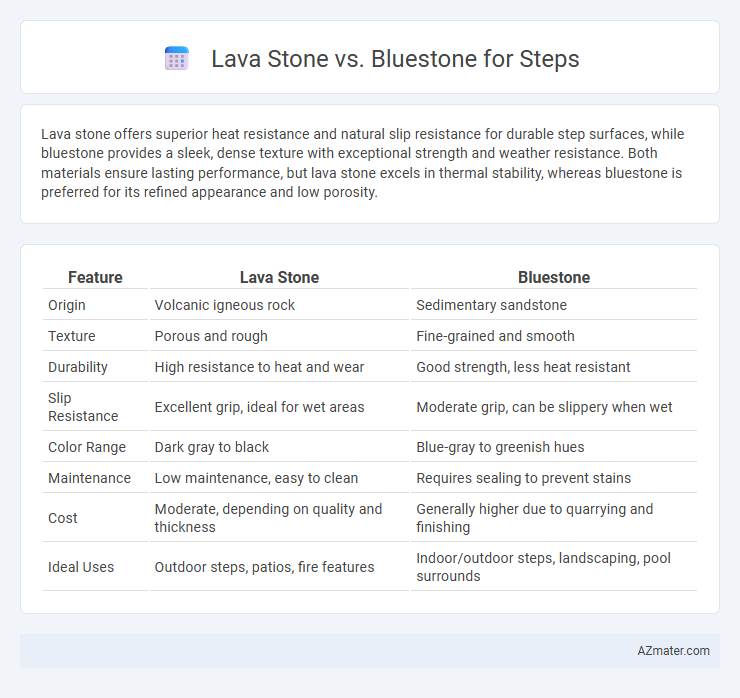Lava stone offers superior heat resistance and natural slip resistance for durable step surfaces, while bluestone provides a sleek, dense texture with exceptional strength and weather resistance. Both materials ensure lasting performance, but lava stone excels in thermal stability, whereas bluestone is preferred for its refined appearance and low porosity.
Table of Comparison
| Feature | Lava Stone | Bluestone |
|---|---|---|
| Origin | Volcanic igneous rock | Sedimentary sandstone |
| Texture | Porous and rough | Fine-grained and smooth |
| Durability | High resistance to heat and wear | Good strength, less heat resistant |
| Slip Resistance | Excellent grip, ideal for wet areas | Moderate grip, can be slippery when wet |
| Color Range | Dark gray to black | Blue-gray to greenish hues |
| Maintenance | Low maintenance, easy to clean | Requires sealing to prevent stains |
| Cost | Moderate, depending on quality and thickness | Generally higher due to quarrying and finishing |
| Ideal Uses | Outdoor steps, patios, fire features | Indoor/outdoor steps, landscaping, pool surrounds |
Introduction to Lava Stone and Bluestone Steps
Lava stone steps offer a porous, lightweight, and heat-resistant surface ideal for outdoor applications, providing natural slip resistance and durability. Bluestone steps, composed of dense sandstone, exhibit a smooth texture with a rich blue-gray color, renowned for its strength and weather resistance. Both materials are popular for landscaping, but lava stone's volcanic origin and bluestone's sedimentary composition create distinct aesthetic and functional properties.
Material Composition: Lava Stone vs Bluestone
Lava stone, composed primarily of volcanic basalt, offers a porous texture that enhances slip resistance and durability, making it ideal for outdoor steps exposed to varying weather conditions. Bluestone, a dense sandstone or limestone, features a fine-grained structure with high compressive strength and a smooth finish that provides both aesthetic appeal and durability in hardscaping applications. The mineral composition of lava stone contributes to its heat resistance and natural textures, while bluestone's sedimentary origins result in a more uniform color and polished appearance, influencing choice based on style and functional requirements.
Durability and Strength Comparison
Lava stone offers exceptional durability and strength, characterized by its volcanic origin, which results in a dense, non-porous structure resistant to cracking and weathering. Bluestone, a dense sandstone, provides strong load-bearing capacity but is more susceptible to surface wear and erosion over time compared to lava stone. When choosing materials for steps exposed to heavy traffic and harsh environmental conditions, lava stone generally outperforms bluestone in maintaining structural integrity and longevity.
Aesthetic Appeal and Color Options
Lava stone offers a rugged, porous texture with deep black or dark gray hues, creating a striking, natural aesthetic ideal for bold step designs. Bluestone features a smoother finish with a diverse color palette ranging from blue-gray to green and rust, providing versatility and a more refined appearance. Both stones enhance outdoor steps, but lava stone emphasizes dramatic contrast while bluestone delivers subtle elegance through varied tones.
Texture, Surface, and Finish Differences
Lava stone features a porous texture with a rough surface that provides excellent slip resistance, ideal for outdoor steps requiring durability. Bluestone offers a denser, smoother texture with a honed or cleft finish, creating a refined appearance suitable for formal stair designs. The finish on lava stone tends to be more rugged and natural, while bluestone's finish can be polished or tumbled, enhancing its visual appeal and tactile contrast.
Slip Resistance and Safety Aspects
Lava stone exhibits exceptional slip resistance due to its porous and rough texture, making it highly suitable for steps in wet or slippery conditions. Bluestone offers moderate slip resistance with a smooth, dense surface that can become slippery when wet, requiring treatment or textured finishes to enhance safety. Prioritizing slip resistance, lava stone provides superior safety for steps, especially in outdoor environments prone to moisture and foot traffic.
Weather Resistance and Performance
Lava stone exhibits exceptional weather resistance due to its volcanic origin, providing superior durability against harsh climates and freeze-thaw cycles, making it ideal for outdoor steps. Bluestone, while also weather-resistant, is more porous and may require sealing to prevent moisture absorption and surface wear over time. Performance-wise, lava stone offers higher slip resistance and minimal maintenance, whereas bluestone's aesthetic appeal comes with moderate upkeep in variable weather conditions.
Installation Process and Maintenance Needs
Lava stone steps require a skilled installer due to their porous and uneven texture, often necessitating sealant application to prevent stains and weather damage. Bluestone, characterized by its dense, smooth surface, offers easier cutting and installation but may demand regular cleaning and resealing to maintain its natural color and resistance to moss growth. Both materials benefit from professional installation to ensure durability, with maintenance routines tailored to their unique porosity and surface hardness.
Cost Analysis: Lava Stone vs Bluestone
Lava stone typically costs between $10 to $20 per square foot, making it a more affordable option compared to bluestone, which ranges from $15 to $30 per square foot. Installation costs for lava stone tend to be lower due to its lighter weight and easier handling, while bluestone requires more labor-intensive cutting and preparation. Long-term maintenance expenses also favor lava stone, as it is more resistant to chipping and weathering compared to the relatively softer bluestone.
Choosing the Right Stone for Your Steps
Lava stone offers porous texture and excellent slip resistance, making it ideal for outdoor steps in wet climates, while bluestone provides durability and a smooth, elegant finish suitable for both indoor and outdoor applications. Bluestone's dense composition resists wear and staining, whereas lava stone's natural roughness enhances traction but may require more maintenance to prevent clogging of pores. Selecting the right stone depends on your climate, desired aesthetics, and maintenance preferences to ensure long-lasting, safe steps.

Infographic: Lava stone vs Bluestone for Step
 azmater.com
azmater.com